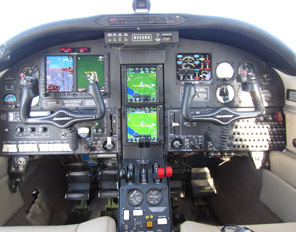 When the Wright brothers took off way back in 1903, even they realised that for a successful and safe flight, the pilot(s) would need an insight into wind direction, wind speed, aircraft altitude, and current location and so on. When the Wright brothers took off way back in 1903, even they realised that for a successful and safe flight, the pilot(s) would need an insight into wind direction, wind speed, aircraft altitude, and current location and so on.
As aircraft development progressed and the inevitable crashes occurred, aircraft inventors realized that aircraft engine status and information about every aspect of the aircraft engine was just as vital as information relating to wind direction, speed, aircraft altitude, and current location. Thus was born the aircraft flight engine instruments.
Aircraft flight engine instruments consisted of a bunch of dials that provided such varied information as oil pressure and temperature, cylinder head temperature (CHT), engine tachometer, propeller tachometer, Manifold Absolute Pressure (MAP), Exhaust Gas Temperature (EGT), fuel and oil levels and so forth.
Of course pilots today have these and much more information at their fingertips. But these aircraft flight engine instruments were and still are the bare minimum that is required for pilots to know the overall health of the engine that powers the flight.
The aircraft flight engine instruments back in the 1900’s were at best somewhat accurate. But it was better to know something than nothing. For example, if the temperature of any part of the engine was rising to levels beyond what they should be, the accuracy of the temperature dial or exact temperature being displayed was irrelevant – suffice that the pilot(s) knew that something was not right and that they should best look out for a safe landing spot i.e. thanks to the Aircraft Flight Instruments, they at least had some advance indication of things to come and could therefore attempt to land before the aircraft caught fire or just fell out of the sky because of a stalled engine.
Pilots flying aircraft today are a lucky lot – even those flying vintage aircraft have reasonably accurate analog Avionic Instruments to rely on. But when it comes to flight safety, none have it better than pilots flying the latest 4-engined commercial aircraft with their state-of-the-art digital aircraft flight engine instruments and avionics. It is pure joy to have every bit of information a pilot could imagine about the aircraft engine and have it provided in a digital form and that too prioritized the way they like it.
Thanks to modern technology and companies manufacturing aftermarket aircraft flight engine instruments (such as J.P. Instruments), today even vintage aircraft can sport the latest space-age aircraft flight engine instruments and avionics in full colour.
Pilots flying aircraft with cockpits still sporting vintage analog dials can now replace all those dials and Aircraft Level Sensors with the latest that technology has to offer. In doing so, they enhance flight safety to a level they never had. Imagine instruments that automatically calculated viability of your destination based on available fuel, wind direction, wind speed, turbulence, altitude and aircraft speed. Actually you don’t have to image it, you can buy it from https://www.jpinstruments.com/ Happy Flying!
|